Excerpts from Jim Conrad's
Naturalist Newsletter
from the January 27, 2013 Newsletter issued from the valley of the Dry Frio River in northern Uvalde County, southwestern Texas, on the southern border of the Edwards Plateau; elevation ~1750m (~5750 ft); N29.62°, W99.86°; USA
DEVIL'S CLAWS
I first met the local species of Devil's Claws when Elvis the Neighbor's Billy Goat stood on his back legs with his front legs atop the fence to greet me as I left the cabin, but this time he wasn't baaing the way he usually was. When I went over to him I saw why he was so quiet: his muzzle seemed to be clamped shut with a muzzle apparently made of stiff wire or hard plastic. Along one side of the muzzle there was a boxlike, woody affair bristling with sharp spines, the longest of them entering Elvis's mouth, surely pricking the goat's lips and tongue. Who could have done such a mean thing to poor old Elvis?
Finally it began dawning on me that this thing around Elvis's mouth was too weathered and irregularly formed to be wire or plastic. Unwrapping it from around his muzzle I began recognizing it as the fruit of an interesting plant known by several evocative names, including Devil's Claws, Cow Catcher, Unicorn Plant, and the Spanish Cinco Llagas, which means "Five Sores." Below you can see two of these fruits attached to the top of the annual plant that produces them, found decaying on the ground:
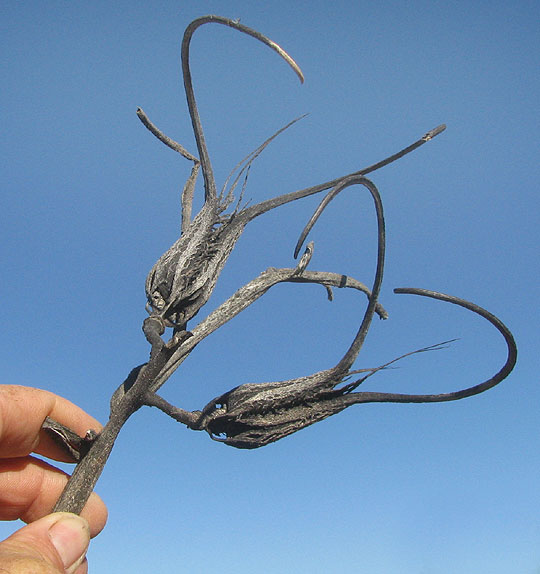
Plants producing these fruits belong to the genus Proboscidea. Four Proboscidea species are listed for Texas, all with similar fruits, thus they are more easily distinguished by their flowers. Only one species is widespread and fairly common, so I'm assuming that that's the one we have here: PROBOSCIDEA LOUISIANICA, of the small Martynia Family, the Martyniaceae. The family is noted for the sticky, glandular hairs that cover its species' vegetative parts, and for the capsular fruits the species produce, with long, curved beaks. Most species in the family occur in the American tropics and subtropics.
Of course Devil's Claws' extraordinary fruits haven't evolved to make animals miserable, but rather to facilitate fruit dispersal. The long "claws" latch onto hairs of larger animals, and entrap the fruits on animal feet. You can see how one fruit hitched a ride on my boot below:
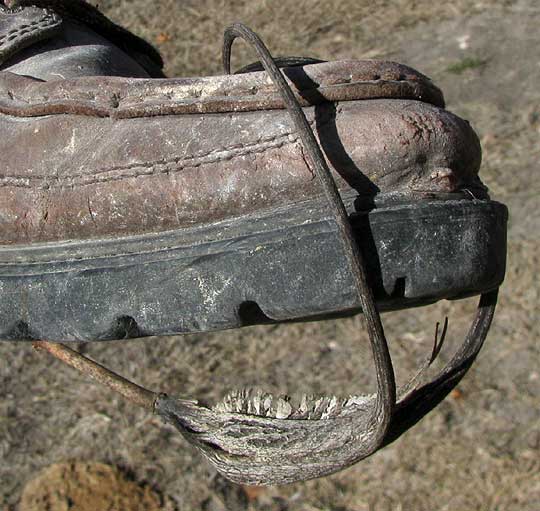
In that picture, notice how the capsule's top bears a crest consisting of numerous woody, jagged scales pointing upward. If the fruit were latched onto an animal's hoof, the scales would hurt with each step. Maybe the plant "wants" the animal to take a few steps, feel the pain, then remove the fruit before wandering so far that it might end up out of its preferred environment.
Devil's Claws' fruits seem to be too large for the animals that might transport them, such as deer. Also, the curved "claws" seem too long for the short fur on our area's animals. Some have suggested that Devil's Claw's fruits are anachronistic -- that they evolved to hitchhike on the much larger, hairier animals that roamed the Americas during the last million years, but now are extinct, such as Giant Ground Sloths.
In Mexico we've encountered another member of the Martynia Family, genus Martynia, which also produced woody capsules with curved claws, but those capsules and claws were much smaller. You might enjoy comparing our present fruits with those at http://www.backyardnature.net/mexnat/devlclaw.htm.
Mature Devil's Claw fruits have been used in basketwork in several indigenous American cultures.
from the August 4, 2013 Newsletter issued from the Frio Canyon Nature Education Center in the valley of the Dry Frio River in northern Uvalde County, southwestern Texas, on the southern border of the Edwards Plateau; elevation ~1750m (~5750 ft); N29.62°, W99.86°; USA
DEVIL'S CLAWS FLOWERING
Nowadays Devil's Claws are flowering, and below you can see one in my garden.
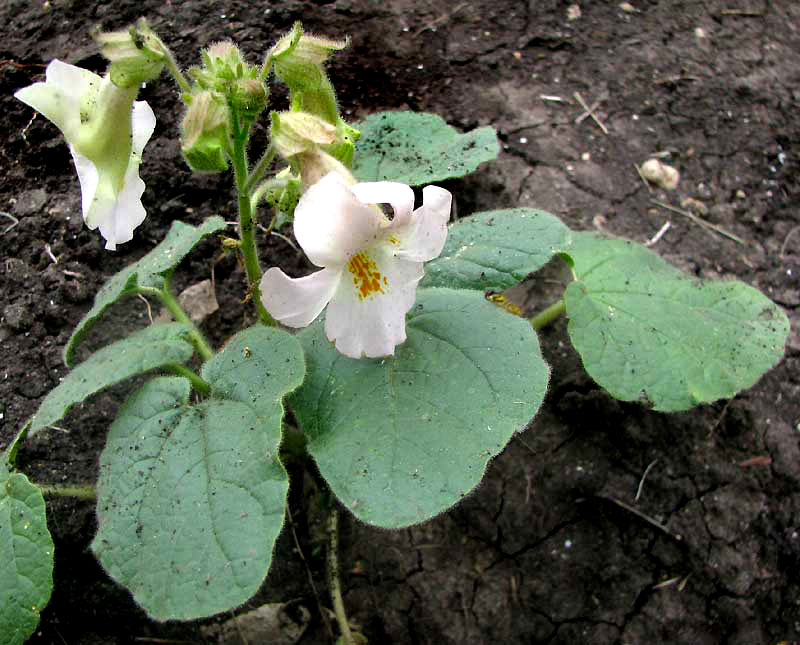
A close-up of a white flower with a syrphid fly in a blur about to enter the flower's throat and follow the golden "nectar guide" to the nectar is shown below:
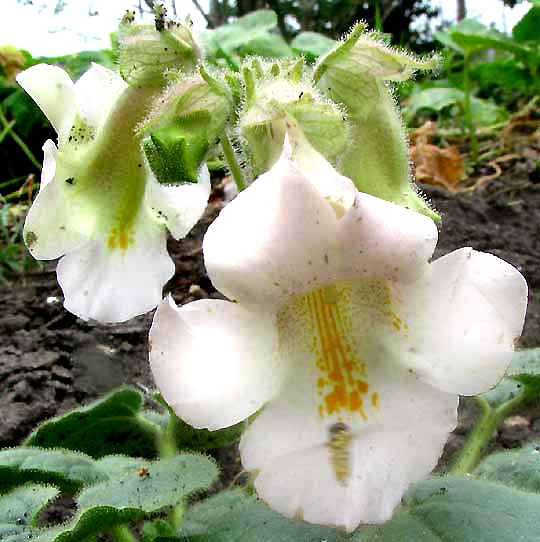
One eye-catching feature of that photo is the dense mantle of gland-tipped hairs covering the calyx and other vegetative parts. The sticky hairs catch and often kill insects that might damage the flower, but there's no evidence that the plant derives nutrients from the capture; the plant doesn't "eat its prey." A close-up of a sepal, or calyx lobe, bristling with sticky, glandular hairs is shown below:
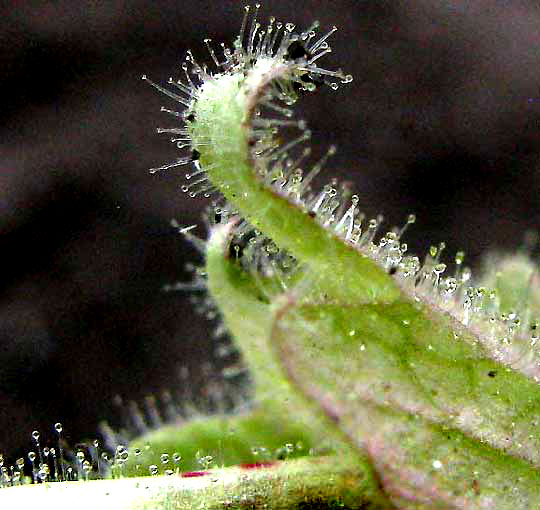
Though fruits of species in the Devil's Claws' family, the Martynia Family, the Martyniaceae, are unlike fruits in any other family, the flowers look a lot like those of catalpa or trumpet creepers, which are members of the Bignonia Family, the Bignoniaceae. In fact, genetic sequencing places the Bignonia family and the Martynia family near one another on the Phylogenetic Tree of Life. A schematic tree showing the two families -- Bignoniaceae and Martyniaceae -- near one another (4th and 5th position from the chart's bottom) can be reviewed at http://www.mobot.org/MOBOT/Research/APweb/trees/lamialesnotl.gif.
Devil's Claws is native to arid northern Mexico and as far north in the US central states as South Dakota, though it's spreading as an invasive weed in much of the rest of North America.
With such unusual fruit and sticky herbage, I'm surprised that I can't find mention of a culture using Devil's Claws medicinally. I'll bet that some people in the past sensed diabolic emanations from the fruit. Such fruits simply stir one's imagination, and it's remarkable that they begin as such normal looking, pretty flowers.
entry dated June 24, 2022, issued from near Tequisquiapan; elevation about 1,900m, (6200 ft), ~N20.57°, ~W99.89°; Querétaro state, MÉXICO
"MULBERRY" COROLLAS IN MEXICO
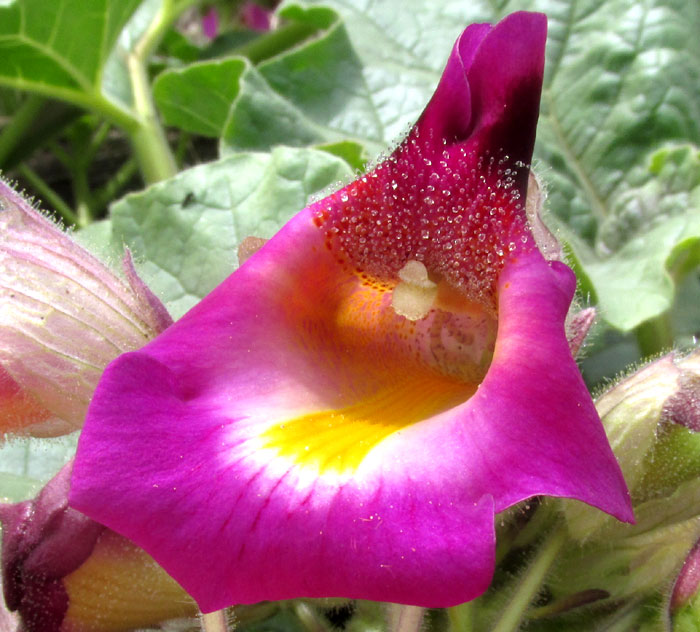
Here in the arid uplands of central Mexico we have lots of Devil's Claws, the same species we had in Texas, but with corollas of the color shown above. Most of my life I'd have called that a purple flower, but in recent years I've tried to be more exact. Basically, when I have a purple flower the Internet is consulted to see what color I should call it in print. On "shades of purple color" charts pulled up, it comes close to magenta, but it's too rosy for that. On the chart with most purple shades, it matches "mulberry."
Here's a shot of our mulberry blossom from the side, its hue somehow fitting very nicely with its white calyx and glistens from the corolla's stalked glands:
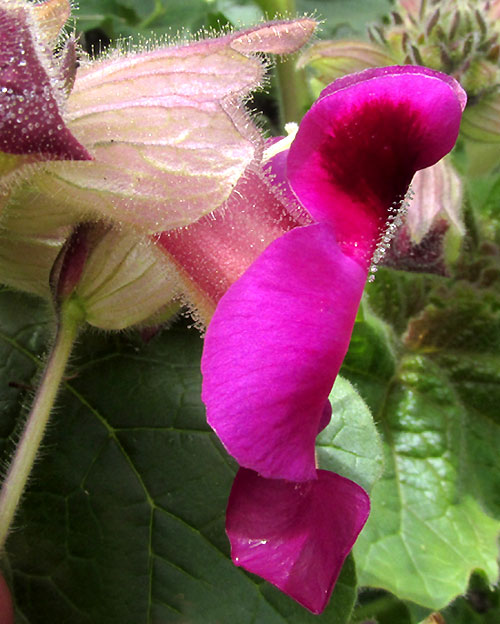
And here's a shot of the glands themselves, a bit different from those photographed earlier on a Texas flower's calyx.
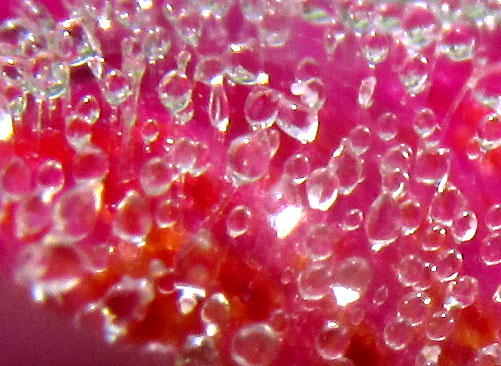
The Flora del Bajío documenting our region's flowering plants says that Devil's Claws' flowers can range from white, yellow, rose or cherry, and violet to purple -- presumably "mulberry purple" -- and sometimes these colors are mixed in banded colors, splotches or dots, all in the same flower. The Flora also says that here we have only the subspecies fragrans, which normally is rose to cherry, and only rarely white. Subspecies fragrans occurs from southeastern Texas south to about the Mexico City area.
Those stalked glands are sticky. At one time Devil's Claws was thought to possibly be carnivorous, but now it's mostly thought of as only "murderous" to gnats and other tiny critters who get stuck in them. The glands are thought to defend the plant against aphids and the like. Dead small insects attract assassin bugs who feed on the victims, and it's not clear how or if this helps the plant.